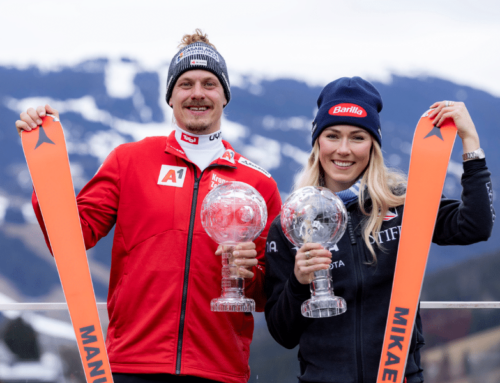Fall line: Learning from Stephen Curry and Tom Brady
Ski racing has plenty of unique characteristics — the variety of conditions, no two venues are the same, course sets vary from one to the next, the differential of winning times sometimes within a hundredth of a second. These unique qualities require unique training environments. However, there are also a lot of commonalities with other sports. In this piece, we will look at two sports and two athletes to see if there are learnings that can help us with our training and development.
Science has proven over and over that it is possible for our minds and bodies to significantly change by adapting to training environments. The study of this phenomenon is called the Study of Expertise. One of the best-known practitioners is Dr. K. Anders Ericsson of the University of Florida. In his book, “Peak, Secrets From The New Science Of Expertise,” he and co-author Robert Pool detail exactly how we acquire World Class expertise. There are two critical components: “deliberate practice,” which is a very specific type of practice, and time — a lot of time.
Physiological adaptation of the mind and body, especially as it is directed by neuronal activity takes a very long time. It is only by firing certain collections of neuronal circuits over and over, for years, that adaptation occurs. That is why otherwise seemingly extremely difficult maneuvers can look easy when done by experts. It’s because they are easy — to the experts, after years of practice.
Deliberate Practice
In order for adaptation to occur optimally the practice needs to fit a certain profile. The activity has to be a moderate challenge that is outside one’s comfort zone, and it requires regular feedback. Just going through the motions mindlessly will not lead to anywhere near the same level of improvement as with deliberate practice. That is why there are millions of mid-handicap golfers. “Playing” golf does not lead to optimal improvement.
There is controversy about the 10,000-hour rule. Malcolm Gladwell introduced this term in the book, “Outliers.” Much of the research behind this book was based on the research of Ericsson. The only problem was, Ericsson never said there was any such rule. What he did say was it took a RELATIVELY huge amount of deliberate practice to reach World Class.
The issue with many professional athletes is when they “make it” to World Class the demands of long competitive seasons make it very difficult to practice enough to do much more than maintain their level. Imagine 82 games in a NBA regular season, plus the playoffs, not to mention all the sponsor obligations. The result is that it is difficult for most professional athletes to continue physiologically adapting once they reach World Class. We are about to meet two athletes who didn’t let that happen.
Stephen Curry
Stephen Curry was average for a basketball player by any standard. Moderately tall at just under 6 foot, 3 inches, average wingspan, average jumping ability, and average explosiveness. Just average. He attended a small Christian high school and received no scholarship offers from any of the top basketball powers. Landing at Davidson, a secondary-ranked school, Curry excelled leading the Wildcats to a Cinderella run at the NCAA tournament making it all the way to the Elite Eight. Still, he was largely considered an average NBA prospect and was drafted as the third guard in the 2009 draft. The consensus of the NBA scouts was Curry was “not a natural point guard that an NBA team can rely on to run a team.” He was positioned as a role player with a very good outside shot.

What happened to this newly minted NBA player whose athleticism was “far below NBA standard?” He became two-time NBA MVP and has been debated as one of the best who ever played the game! What gives?
Most attribute a portion of his success to growing up in a family seeped in basketball development knowhow. His dad, Dell Curry, who played for 16 years in the NBA, took keen interest in Steph’s development from a young age. He was quoted saying, ”I guess we started him probably when he was 6 or 7 in a rec league. He had been around it his whole life, obviously with me playing in the NBA, so it was nothing new to him. But he started at a very young age and we just tried to make sure he got the proper skill set, the proper teaching of skills and fundamentals so that he grew and developed his game. He had to overcome learning to play without being the most athletically gifted or biggest guy. Being around NBA players really helped him because it taught him the game. He was at all the practices.”
Curry Senior’s advice for parents? “Just be as supportive as you can and give them as many resources as you can to develop their game and be as good as they can be at their sport.” Deliberate practice.
The second component of Curry’s breakout is his work. He has a tremendous work ethic, and he works smart. His warmups before games at the Golden State Warriors became so popular they started selling separate tickets just to be able to watch his hour-and-a-half practice sessions. He had a coach work with him and disrupt his shots and give him signals of which skill to execute. Sometimes he wore strobe glasses. All of this is intended to take him outside his comfort zone and create deliberate practice opportunities. After watching him continue to develop after reaching the NBA, it’s at least somewhat understandable how he broke the three-point record by making 403 of them in one season, breaking the previous record by 116.

It isn’t only his in-season work, but his off-season work, as well. During the 2011 lockout-shortened season, Curry was looking for training near his home close to Charlotte, N.C. Enter Brandon Payne who operates a training facility specializing in rehab and skill development. Payne had trained other NBA athletes and embraced Curry immediately after meeting him. Curry had shown a lot of promise but had not topped 20 points per game. Payne says, “I had always admired Curry and he was a guy that I really wanted for my philosophy because he fit it so well.” Just hours after their first workout, he got a text from Curry: “Hey, can we go tomorrow morning and get some work in?”
Payne utilizes a development tool called neurocognitive efficiency. That is a training method that focuses on overloading the athlete with multiple tasks. Essentially, this involves bombarding the athlete with extraneous sensory stimulus while continuing the general skill you are working on. Effectively Payne is creating deliberate-practice opportunities when it would otherwise be difficult to impossible. Imagine practicing stagnant dribbling or shooting in a gym with perfectly replicable conditions. To continue building the neural circuits necessary to improve it requires challenge and feedback. It isn’t about the body. It’s about the neural circuits that control the body. That is the magic of Steph Curry.
Tom Brady
Tom Brady, similar to Steph Curry, was not an overnight success. He was a third-string quarterback on his high school freshman team. He played JV his sophomore year and varsity his junior and senior year. He was clearly a very good athlete playing football, basketball and baseball. The latter well enough to be drafted out of high school. But nothing in his background indicated he might be the greatest quarterback of all time. He did receive a scholarship to Michigan, but was seventh on the depth chart as a freshman, backup as a sophomore and shared the starting duties as a junior. In his senior year, he took the Wolverines to an Orange Bowl victory over Alabama.
Brady was not a highly sought-after NFL draft choice. He was drafted 199th in the 2000 NFL draft by the New England Patriots. According to USA Today, here was one scouting report on Brady at the time of the draft: “Poor build, skinny, lacks physical stature and strength, lacks mobility and ability to avoid the rush, lacks a really strong arm, can’t drive the ball downfield.” Somehow, that doesn’t sound like a candidate for the greatest of all time.
How does one go from the 199th draft choice one year to arguably the best ever? Brady has been described as the tortoise of the NFL. He became known for his tireless work ethic, his insatiable dedication to studying game films of opposing defenses. Like Curry, he works year-round on his strength and fitness with a special coach that he pays for himself. Alex Guerrero, his conditioning coach, was introduced to Brady by other Patriot players. They ultimately became very close with Guerrero becoming godfather to Brady’s child. They ultimately went into business together, forming TB12 Sports fitness Center.

Guerrero also introduced Brady to diet. Brady has his own personal chef. He is very particular about a science-based diet. His diet consists of 80% vegetables and whole grains. He does not consume any white sugar, white flower, caffeine, dairy, or plants that cause inflammation, such as tomatoes and mushrooms. His chef only cooks with coconut oil.
There are several lessons we can take from Tom Brady:
1) Nurture not nature. Brady was never described as a natural athlete. He started behind others at every level, in high school he first started as a junior, same at Michigan, and he was fourth on the depth chart at New England. Absolutely NO ONE would have predicted his success. Brady is described as one of the hardest workers in the game. He committed to deliberate practice for years and years until he developed into arguably the best in the game, maybe the best ever.
2) He used technology. He spent countless hours studying video. Science has shown that in addition to programming circuits by deliberate practice, you can also program circuits by vivid imagination. We have an example in ski racing. Mikaela Shiffrin once told me she could watch video and change the perspective at will. What she said was she could watch a video taken from a front view and recreate it from an athlete’s view. I have never heard anyone else say that. It comes from countless hours carefully studying video.
3) Injury prevention. Brady’s commitment to year-round fitness in a very deliberate manner and diet took him to a different level than his peers. That is why he is still at the top of his game at 43 years of age, the longest-serving quarterback in the NFL.
Curry and Brady are just two examples that any scientist would say are anecdotal examples, not scientific proof of nurture versus nature. But given that there is science behind this principle and many, many examples in ski racing, I propose it is irrefutable that ski racers can be made and are not necessarily born.
Editor’s note: This story is part of our ongoing series on alpine development in North America. Have some thoughts on this? Send a letter to the editor. If it’s good, we’ll publish it.





















